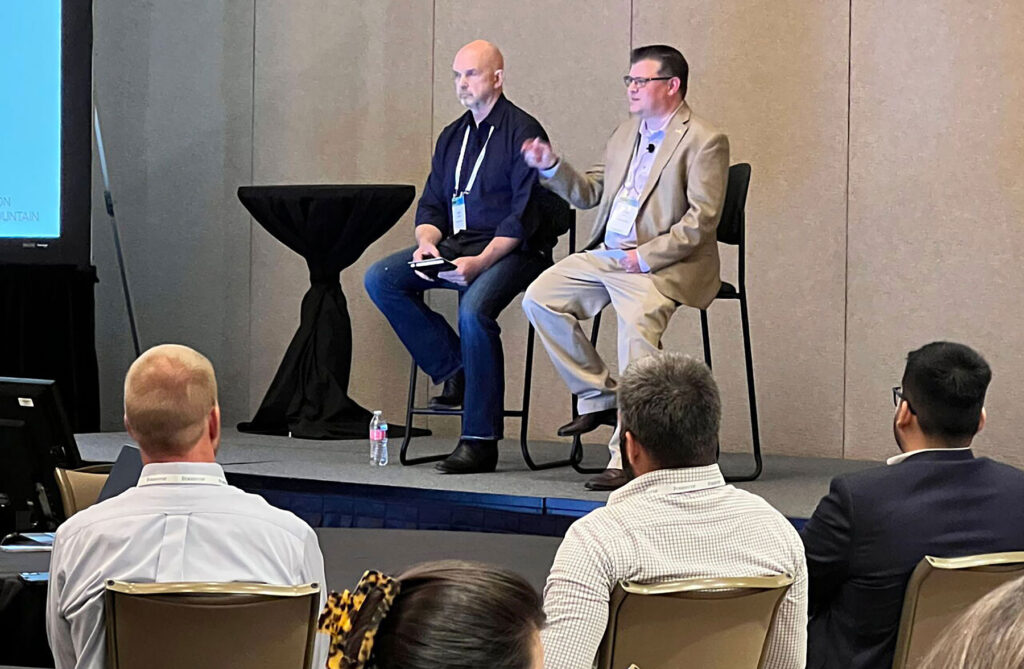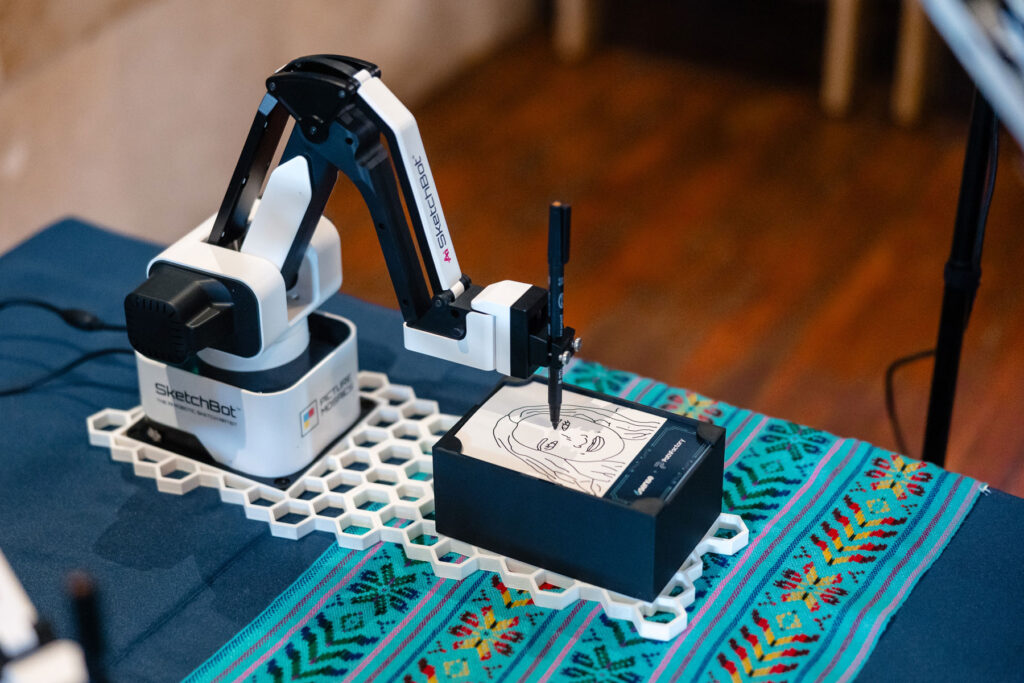This week, hundreds of marketing, sales, and product leaders gathered in Austin for Forrester’s B2B Summit North America, all keen to discover ways to successfully navigate this tricky time of economic and technological disruption.
Practically everyone here focused on the crucial importance of aligning marketing, sales, and ops teams into a cohesive unit with common goals… and using unified data and insights to achieve them.
6sense and our partners led the charge, sharing hard-earned insights forged by team alignment, frameworks for revenue generation, and ROI-boosting success stories. Read on to learn what we were up to deep in the heart of Texas!

Becoming Architects of Opportunity
In a packed session, 6sense CRO Latané Conant and SVP Marketing & Revenue Analytics Saima Rashid revealed 6sense’s new Revenue Creation Framework, a proven blueprint for unified revenue creation.
Highly informed by 6sense’s own success ($200M in 6 years!), the framework focuses on smart data management, analytics, campaign execution, and revenue team alignment.
Ask Big Questions, Seek Granular Answers
Firstly, Latané and Saima advised revenue teams to take a hard look at their processes to gain clarity on what they’re doing and how they can improve. For instance:
- Which marketing activities are driving engagement within your Ideal Customer Profile? Double down on these tactics.
- Make sure to track the percentage of your ICP that’s engaged. (If the percentage is low, there’s obviously room to grow.)
- Determine your top drivers of engagement — and get specific. The goal is to zero in on what’s most or least effective.
- Uncover winning patterns across the org. Collect keywords, campaigns, contacts/personas, and web content, and study how many activities it takes to move prospects from one pipeline stage to the next.

Create Clear Processes and SLAs
Get equally detail-oriented on your team’s workflows, Latané and Saima said, keeping a focused eye on improvement and accountability. As an example, they shared how 6sense’s Business Development Representatives up-leveled their BDRs’ performance when responding to leads.
After identifying room for improvement, 6sense sales and marketing leaders implemented new SLAs for BDR response times, and required BDRs to follow those responses with robust multi-threading.
For outbound 6sense Qualified Accounts (aka “6QAs,” when an account moves from an earlier buying stage to a later one, making them qualified for sales activity), BDRs now had to:
- Respond within 20 minutes of being notified the account had been qualified, and
- Engage at least three personas by the time the account executive meets with the buying committee (Stage 2 in 6sense’s sales pipeline).
For inbound 6sense Qualified Leads (aka “6QLs,” when an account shows the right signals of high intent and ready for sales outreach), BDRs had to:
- Respond within six minutes of receiving those leads, and
- Engage at least three personas by the time the account reaches Stage 2.
To ensure accountability, leaders monitored response times and outreach, and supported improvement through robust training and enablement. The end result: BDRs achieved a 4x quicker response time within just three months.
Six Pillars for Success
These activities and improvements are crucial differentiators, Latané and Saima explained. But data can only get you so far. To power a robust GTM framework, teams need the right tools to convert data into intelligence.
Based on our own success, we developed the 6×6 Revenue Creation Framework, which consists of six key pillars:
- Understanding the Market
- Defining Revenue Strategy
- Creating Demand
- Capturing Demand
- Managing Opportunities
- Growing Customers
Within each pillar are six focus areas for marketing, sales, and customer success teams to jointly execute. Here’s the spectrum of strategies and activities 6sense’s revenue team consider within our own process:
| Understand Your market | Define Revenue Strategy | Create Demand | Capture Demand | Manage Opportunities | Grow Customers |
| Target Market & ICP | GTM Model(s) | Build Brand, Market & Category Leadership | Revenue Plays | Sales Process | Onboarding / Adoption / Usage |
| Persona/Buying Team | Segmentation | Campaign Tiering & Planning | Prioritization | Sales Content & Enablement | Stakeholder Engagement |
| Intent & Buying Behavior | Pipeline Plan | Reach Your Audience | Routing / Assignment | Buying Team Engagement | Customer Community |
| In-Market Buyer Identification | Territory Design | Engage Your Audience | Outbound Prospecting | Forecasting & Deal Inspection | Competitive Risk |
| Competitive / Market Insight | Budget Planning & Org Design | Qualify Accounts & Leads | Multi-Threading | Accelerate Deal Cycles | Cross-Sell |
| Ecosystem | RevTech Stack | Optimize Inbound | Activity Tracking & Inspection | Business Case / Value Plan | Advocacy |
Successful implementation of these activities requires alignment at every level. Technology can help organizations achieve that. But it takes tech that’s been purpose-built to make these kinds of intelligent recommendations, and to help eliminate effort across the org.
For instance, Latané and Saima shared how technological innovations within 6sense’s platform will empower sellers to maximize their impact while minimizing effort:
“Sellers hate prospecting,” Latané told attendees. “We’ve got to make it easier for them to meet — and then beat — their goals.”
6sense’s innovations bring untold efficiencies to the sales process, like:
- Never build manual lists or manually hunt for contacts again: The platform can recommend or pre-fetch the most relevant contacts, knows who to engage on the buying team, and provides necessary context so sellers understand why the AI is making these recommendations.
- Never wonder what to say: The platform conducts account research for sellers, while generative AI assembles and summarizes the most relevant account insights. This means sellers know exactly what to say to engage prospects.
- Never write an email from scratch: 6sense’s AI-powered email writer does the heavy lifting for sellers, generating personalized emails based on key account insights and buying stages. Sellers can quickly review the AI’s reasoning and customize the email with a few clicks.
The key to predictable revenue growth is aligning the revenue team around a common operating framework, Latané and Saima concluded, using AI and automation to enable personalized engagement at scale — and fostering the right culture of accountability and alignment.
Intent Data to Drive Greater ROI: Iron Mountain Case Study

In another presentation, Iron Mountain’s Marketing Ops Director, Jack Speyer, and Senior Manager for Demand Optimization in the Americas, Scott Stano, shared how the organization achieved a 21:1 ROI with 6sense.
In 2022, Iron Mountain embarked on an ambitious growth plan called “Matterhorn.” The goal was to significantly expand the company’s product offerings, reputation, and market share in the storage and services industry. For the initiative to succeed, the revenue team needed more visibility into their customers.
They launched 6sense in 2023, which provided visibility into where prospects were in their buying journey, and what solutions those buyers were actively researching. This enabled Iron Mountain to tailor their approach with precision.
While the technology itself was a critical component to their strategy, success also required aligning teams and streamlining processes to ensure a cohesive approach.
Stano said, “We trained Inside Sales and Demand teams across different time zones and go-to-market strategies, ensuring everyone was equipped to leverage the platform effectively. And while adoption started in North America, we quickly expanded globally, sharing learnings, segments, and successes across regions.”
Training and repetition were also crucial in the implementation of 6sense. Speyer, Stano, and other revenue leaders created a supportive environment where questions were encouraged, ensuring that everyone felt comfortable using the tool. They also identified power users who served as internal champions, driving adoption and facilitating knowledge sharing.
The transformative impact of intent data on sales and marketing practices was evident in Iron Mountain’s journey. By using the 6sense platform, they:
- Refined their targeting
- Aligned teams and processes
- Enhanced the effectiveness of their digital spend
“Ultimately, our journey with 6sense taught us valuable lessons in communication, alignment, and persistence. While it may not happen overnight, the benefits of aligning sales and marketing with powerful tools like 6sense are undeniable,” Speyer said.
We Came, We Saw, We Mixed & Mingled

6sense also made a splash with our VIP Club6 lounge. With a speakeasy vibe, Club6 offered attendees a unique networking experience, with:
- An oxygen bar
- Photobooth
- AI-powered “sketchbots” that drew pictures of attendees
- A jewelry-making booth.


We loved getting to reunite with familiar faces and make new connections!
We also hosted breakfast events on both Monday and Tuesday to fuel our bodies and minds for the days’ sessions.

Matt Hummel, VP of Marketing at Pipeline360, led a thought leadership breakfast focusing on the future of demand generation. Director-level marketing and demand gen professionals gained insights into the current state of B2B marketing, changes impacting teams today, and strategies to overcome challenges.
We also hosted a breakfast for CMOs, sponsored by G2 and Qualified. Attendees enjoyed time to network and partake in lively roundtable discussions.



